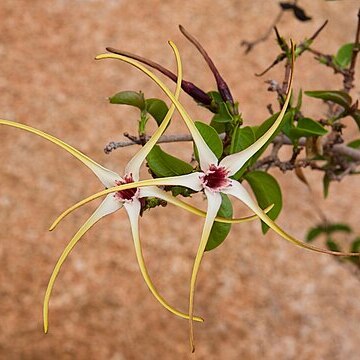Sarmentose shrub 1–3.5 m high or liana to 20 m long, deciduous, flowers appearing with the leaves, trunk to 10 cm in diameter, bark reddish brown or grey-brown; branches scabrid; branchlets densely hispid; latex clear, white or yellow.. Leaves opposite; blade often convex, ovate or elliptic, 8–24 cm long, 5–17 cm wide, base cuneate, rounded or subcordate, apex obtuse, acute or acuminate, densely hispid on both surfaces but glabrescent above; petiole 1–5 mm long.. Inflorescence 1–12-flowered, pedunculate, fairly congested, densely hispid in all parts; pedicels 3–20 mm long.. Flowers fragrant; sepals narrowly ovate or linear, 9–27 mm long, acute; corolla white turning yellow, red-spotted inside; corolla tube 13–24 mm long, corolla lobes ovate, 3–16 mm long, 4–9 mm wide, narrowing into the 9–20 cm long pendulous tails, corona lobes 1–3 mm long.. Fruit hard, the mericarps opposite-divergent, cylindrical or nearly so, 15–47 cm long, 1–2.6 cm in diameter, tapering to a knob, lenticellate, hispid and glabrescent; seeds 11–21 mm long, densely pubescent, with a stalked coma 6–14 cm long.
Corolla tube 13–24 mm. long and widening at almost 1/2-2/3 of its length into a cyathiform upper part, at the mouth (6)8–14 mm. wide, densely hispidulous outside except for the base, sparsely hispidulous inside except for the base; corona lobes Ungulate, 1–3 x 1–2·4 mm., minutely puberulous or papillose; corolla lobes ovate, 3–16 x 4–8·5 mm., gradually or fairly abruptly narrowing into the pendulous tails; lobes (including the tails) 100–160(–200) mm. long, puberulous except for the inner side of the tails.
Leaves petiolate; petiole 1·5–5 mm. long; lamina dark green, paler beneath, ovate or elliptic, less often obovate or nearly circular, 1·1–2·3 times as long as wide, in mature leaves 8–23·5 x 5–16·5 cm. cuneate, rounded, or subcordate at the base, obtuse, acute, or acuminate at the apex (acumen 1–11 mm. long), papyraceous or chartaceous, in young leaves densely hispid on both sides, in older leaves glabrescent above, with 7–13 pairs of secondary veins; tertiary venation conspicuous beneath.
Follicles divergent at an angle of 180°, long tapering toward the apex and ending in a small or large knob, rarely without knob and then with an obtuse apex, 15–47 cm. long and 1·3–2·6 cm. in diam.; exocarp thick and hard, densely hispid or pubescent in young fruits and glabrescent when maturing, especially on the adaxial side densely lenticellate.
Shrub or woody climber. Leaves hispid-tomentose, large, usually broader than 45 mm. Cylindrical basal part of corolla tube ± as long as upper, campanulate to funnel-shaped part. Flowers cream to yellowish with red or purple markings.
Ovary 0·8–1·7 x 1·5–2·3 mm., densely hispid with long erect hairs, sometimes glabrous at the base; style 6·5–13·5 mm. long; clavuncula 1–1·8 x 0·9–1·3 mm.; stigma minute.
Seeds with the grain 11–21 x 2·5–4·5 x 1·5 mm., densely pubescent; rostrum glabrous for 20–57 mm. and bearing a coma for 20–42 mm.; coma 42–80 mm. long.
Sarmentose shrub, 1–3·5 m. high, or liana, 2·5–20 m. high, deciduous, flowers and leaves appearing at the same time; latex clear, white, or yellow.
Trunk up to 10 cm. in diam.; bark reddish-brown or grey-brown; branches scabrous as the result of persistent hair-bases; branchlets densely hispid.
A climber. It can be 7 m long. The leaves are 8-16 cm long and 5-10 cm wide. The fruit are follicles 20-40 cm long and 2-3.5 cm wide at the base.
Stamens included for 2·7–7·3 mm.; filaments curved, 0·6–1·2(2) mm. high; anthers 3·7–6·2 x 0·6–1·1 mm., glabrous; acumen 0·1–0·5 mm. long.
Inflorescence 1–12-flowered, pedunculate, fairly congested, densely hispid in all parts; pedicels 3–14(20) mm. long; bracts sepal-like.
Sepals subequal, narrowly ovate or linear, 9–20(27) x 1·5–3·5 mm., acute, densely hispid.
Roots thick and fleshy.
Flowers fragrant.

